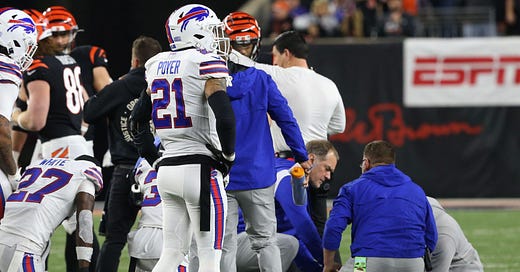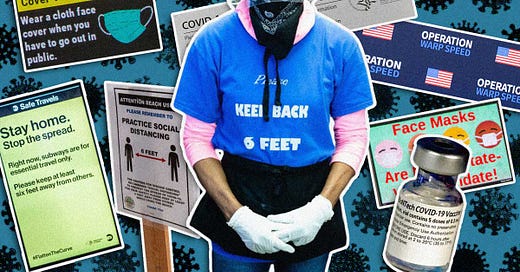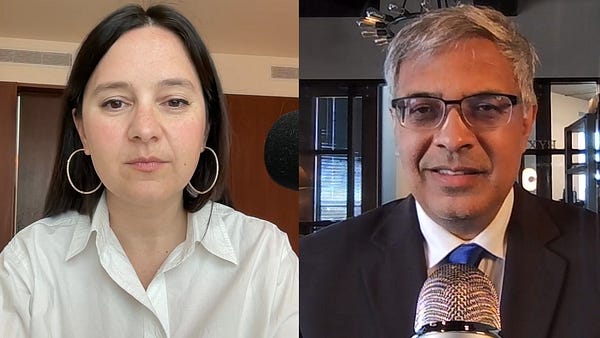
The Free Press

Why are so many people, many of them quite young and seemingly in the peak of health, dropping dead? Today, the news of such events is so inescapable that it feels like an epidemic.
Perhaps the most high profile of these was the near-death, on national television, of 24- year-old Buffalo Bills football player Damar Hamlin. Hamlin went into cardiac arrest after a routine hit during a game earlier this month. He was ultimately saved by prompt medical care. But during the drive from the field to the hospital, Hamlin became a potent political symbol.
Across social media, prominent pundits and activists—most on the right but some on the left—tied Hamlin’s injury to the Covid vaccine. “Prior to 2021, athletes collapsing on the field was NOT a normal event. This is becoming an undeniable (and extremely concerning) pattern,” tweeted Lauren Witzke, who was the Republican nominee in the 2020 Delaware Senate race. Social media was abuzz with similar speculation.
A troubled, uncertain public is increasingly turning to a single, ominous explanation for such events: Covid vaccinations, especially those from Pfizer and Moderna that use the new mRNA technology.
On Twitter, an active subculture using variations of the hashtag #DiedSuddenly tracks such unexpected deaths—a teenage basketball player dropping dead; a track star collapsing on the field; a young teacher dying of a heart attack in front of her class—and implies that vaccines are the cause. A discredited anti-vaccine documentary, Died Suddenly, has reportedly been seen by millions. And the night of Hamlin’s collapse, Fox News host Tucker Carlson, referencing a supposed study of sudden deaths among Europeans athletes, made the debunked claim that “Since the vax campaign began, there have been more than 1,500 total cardiac arrests. . . and two-thirds of those were fatal.”
Is there truth to any of these claims? Is the public right to be concerned? Are there actually more healthy people dropping dead than usual—or is this simply confirmation bias at work? Can we dismiss anything that travels under the banner of “died suddenly” as conspiracy theorizing? And how should we understand why so many Americans are drawn to this explanation?
At least part of the answer to that last question is the serious information void on this subject—which is what we want to remedy in this essay. One of us is a practicing cardiologist (John Mandrola). The other is a practicing hematologist and professor of epidemiology (Vinay Prasad).
Cards on the table: we think the vaccines are an important tool for preventing severe illness and death among vulnerable people—particularly the elderly and those with certain underlying medical conditions. But we have been concerned that our federal officials recklessly continue to push for multiple Covid shots for everyone five years old and up, despite the growing evidence that these vaccines may not be appropriate for all. We are also concerned about the way side effects of the vaccine, particularly among young men, have been downplayed.
For these reasons and more, we believe in being transparent and honest with a public that has lost trust in our essential public health institutions.
What are the side effects of the vaccine?
If you are one of the many millions of Americans who received the vaccine, chances are you had short-term side effects, such as a day spent in bed, arm pain, chills, fever, and headache—all common responses to many vaccines. But Covid-19 vaccines have been linked to more serious events.
Shortly after the release of the vaccines, those developed by Johnson & Johnson and AstraZeneca (which use a different technology than Pfizer and Moderna) were linked to a clotting condition that caused fatal strokes in a small number of women of childbearing age. The condition is so dire that its clear link to the vaccines was discovered relatively quickly, despite occurring at extremely low rates. We both argued early on that the J&J shot should be severely limited, if not outright banned, for women under the age of 55. This was for the simple reason that a safer alternative (the mRNA vaccines) existed for this age group, and that the clotting side effect was absolutely catastrophic.
Indeed, for very young women, or for women who had recovered from a Covid-19 infection, we thought that skipping the vaccine entirely was preferable to getting the J&J. The safety signal for this shot was noted in April 2021, but it wasn’t until the following December that the Food and Drug Administration (FDA) took the soft action of deprioritizing the vaccine, when it should have gone further and removed it.
Most vaccinated Americans, however, get either the Pfizer or Moderna vaccines, and it is the rare but serious side effect from these shots that generates most of the public concern. This side effect is myocarditis, an inflammation of the heart muscle. Nearly all of the accusations of #DiedSuddenly imply injury from vaccine-induced myocarditis.
Myocarditis is not a trivial condition. Hospitalization is often required, and, after release, restrictions are put on patients regarding athletic activity and exertion.
How common is this side effect?
At first, public health officials were dismissive of myocarditis concerns. But even after they had to acknowledge the existence of vaccine-related myocarditis, they continued to downplay its significance. A joint statement in October 2021 from the CDC and the Department of Health and Human Services said of the condition: “Only an exceedingly small number of people will experience it after vaccination. Importantly, for the young people who do, most cases are mild, and individuals recover often on their own or with minimal treatment.”
Some experts cited studies that showed that the risk was very low—in the range of 1 in 100,000 vaccinated people. Such estimates were true, but hid a critical nuance: post-vaccine myocarditis occurs at much higher frequencies—estimates are up to 30 times higher—in healthy young males. The difference in incidence of myocarditis for this population is crucial, especially given that young people have the lowest risk for serious complications from the virus itself.
The risk of developing myocarditis rises after the second dose of vaccine, and Moderna is implicated more often than Pfizer. As a result, some European and Scandinavian countries have limited the use of Moderna in people under age 30.
This winter, the Danish Health Authority recommended boosters only for people over age 50—and those under 50 who have specific medical conditions. People under 18 are not offered Covid-19 vaccines (with limited exceptions) because, the authority says, “Children and adolescents rarely become severely ill from the Omicron variant of covid-19.” The UK government also limited their 2022 autumn booster to adults over 50.
By now we were supposed to have a better idea of how often heart inflammation affects people aged 16 through 30 who get the Pfizer vaccine. The FDA authorized Pfizer to conduct a study on this population to look for subclinical myocarditis. It was scheduled for availability at the end of last year, but to date, no news on this pressing issue has been forthcoming. The failure to report this data is notable in light of a recently published study from Thailand, which reported one case of myocarditis and seven cases of cardiac enzyme elevations in 300 adolescents who received two mRNA vaccinations.
Two additional studies published in the past few months have raised concerns about the connection between the mRNA vaccines and myocarditis. A group at Harvard examined blood from children hospitalized for myocarditis after a Covid-19 vaccination and compared it to blood from healthy children without myocarditis who also had the vaccination. Their main finding was striking and unexpected: the children with myocarditis had dramatic elevations in the circulating Covid-19 spike protein generated by the vaccine. This suggests that prolonged exposure to the spike protein may be a causal factor in vaccine-caused myocarditis.
The second study, from Germany, reported autopsy findings from 25 people who died unexpectedly within 20 days of receiving a Covid-19 vaccination. In four, acute myocarditis appeared to be the cause of death. Notably, the four affected persons were older adults. These results are not definitive, but the authors called for more detailed studies exploring the possibility of fatal adverse events from the vaccine.
Aside from myocarditis, two recent potential safety signals have also emerged. One is that the original Pfizer and Moderna vaccines may result in a risk of blood clots in the lungs. The other is that the newly released Pfizer bivalent booster—a shot that adds protection against the Omicron strain of the virus—may be associated with an increased risk of strokes in people over 65.
We hope these signals turn out to be nothing. But it is incumbent upon our public health officials to do something different from their recent pattern—that is, they should look into this evidence thoroughly, then report their comprehensive findings to the public, making all their data available so independent scientists can analyze it for themselves.
If someone has cardiac arrest, how can you know the cause?
It is difficult—sometimes impossible—to find the underlying cause for why a seemingly healthy person dies suddenly of cardiac arrest. When someone survives cardiac arrest and is stabilized, as Damar Hamlin thankfully was, doctors will order a battery of tests to determine the cause. Causes can include conditions that have nothing to do with vaccination, such as anatomical abnormalities or overly thickened heart walls.
Myocarditis, though generally not fatal, can be. When it is, death is caused by a super-rapid heart rhythm called ventricular tachycardia/ ventricular fibrillation. VT/VF, as we call it, can occur shortly after contracting myocarditis. It can also occur more than six months after the condition has apparently resolved. In that case, the problem is that scar tissue created in response to heart inflammation can be the source of the rhythm disturbance. It’s one of the reasons we feel that even the slightest bit of inflammation in the heart should be treated seriously.
But making the connection between the vaccine, a case of heart inflammation, and a cardiac arrest is quite difficult.
Take the following theoretical example: a young man received the Covid-19 vaccination on January 1, had an episode of chest pain and myocarditis on January 10, and on January 15, suffered cardiac arrest and survived. Then, a few days later, a cardiac MRI scan showed evidence of heart inflammation. In this case, most doctors would feel comfortable saying this was a response due to the vaccine. But if another young man had a similar vaccination and heart rhythm issue, but nothing pointing to inflammation was found upon testing, then the cause couldn’t easily be ascribed to the vaccine.
At the time of Hamlin’s cardiac arrest, many cardiologists who spoke publicly about the case suggested it was likely commotio cordis, a rare event in which blunt impact to the chest causes cardiac arrest in a healthy heart. This remains speculation because to date, Hamlin’s doctors have not released their assessment.
But let’s say the patient didn’t survive. This kind of sudden death in a young person would prompt an autopsy. As the German study demonstrated, an autopsy should be able to reveal acute inflammation of the heart. But a small scar that occurred years earlier, and was a cause of ventricular fibrillation, might be missed.
How would one know if more people are dying suddenly than expected?
There have always been tragic and unexpected deaths of evidently healthy young people. And while it may seem as though more such cases are happening now, that doesn’t tell us whether there really is an increase. For one thing, because there is such high interest in this subject, cases are in the news that might not have been a few years ago.
A recent op-ed in The Wall Street Journal asserted that there were many “excess deaths” —that is, more than the number normally expected—during 2020 and 2021 that were not attributable to Covid. These non-Covid deaths were strikingly high, 30 percent above expectations, the authors say, for those between the ages of 18 to 64. They attribute these deaths to the deadly effects of lockdown: deaths from drug overdoses, alcoholism, and homicide, as well as from diseases like diabetes and heart disease. They write: “The CDC data show the rate of non-Covid excess deaths in the first half of 2022 was even higher than 2020 or 2021. These deaths therefore likely already exceed 250,000, disproportionately among young adults.”
But we don’t know anything about how many of the heart-related deaths of the past two years can be attributed to vaccines, as opposed to the harms of lockdown, or multiple other causes. To establish this would require painstaking statistical work. Moreover, the best efforts would have to take advantage of what are known as natural experiments—that is, variations that have occurred between otherwise comparable groups for essentially random events. Economists make a living looking for such events, and their skills are desperately needed here.
What’s up with our government health officials?
We believe the feverish speculation that Covid-19 vaccines have led to increased sudden deaths is largely due to a trust problem with our public health leaders. And Americans have good reasons for their skepticism.
For example, when the evidence emerged that myocarditis in young males was linked to the mRNA vaccines, the Biden administration denied it: “We have not seen a signal and we’ve actually looked intentionally for the signal in the over 200 million doses we’ve given,” Rochelle Walensky, CDC director, said last April. This was despite the fact that it had been reported by researchers in Israel two months earlier.
When further studies confirmed a link to heart inflammation in younger males, instead of acknowledging that the evidence was concerning and requiring changes to vaccination recommendations to protect this group, officials pivoted. They asserted that vaccine-related myocarditis was not a big concern. Walensky described the myocarditis findings as “these mild, self-limited cases.” They also pushed the line that infection with Covid-19 itself—as is true of many viruses—can cause myocarditis, and that this was a far bigger danger.
We dispute both claims. The majority of young people with vaccine-related myocarditis are hospitalized, and then given long lists of activities to avoid. That is serious. And the evidence for the assertion that a Covid-19 infection is a big heart risk for young people is unconvincing.
Another front on which the government has not been forthcoming is the question of whether or not the vaccines actually prevent the spread of the disease. Last January, Walensky finally acknowledged what millions of people who had gotten the shots, then came down with Covid-19, could have told her—that the vaccines do not prevent people from getting or spreading the illness. Walensky herself contracted the virus for a second time last October, a month after she was boosted with the new bivalent vaccine she wants everyone to take.
People expect leaders to incorporate changing information into their messaging. For instance, since the vaccine does not prevent transmission, there was no longer a societal benefit in getting vaccinated. It should have become a personal health decision. But this message never came—just the opposite. Our health officials have been pushing boosters on everyone from kindergarten on up.
Even worse, many colleges, following CDC guidance, are mandating the new bivalent booster for all students. That means that these schools are violating the rights of bodily autonomy in young people, and increasing their risk of a vaccine side effect for no purpose.
Yet another unanswered question is why U.S. public health leaders, unlike many others around the world, do not consider natural immunity from contracting Covid-19 when making vaccination recommendations. Our officials simply ignore the growing evidence that a Covid infection confers resistance to reinfection as effectively, or even more so, than vaccines.
News this week about the FDA indicates that a change is coming to the current vaccination recommendations. Officials are expected to call for an annual dose of a Covid-19 vaccine, similar to the flu shot schedule. But there is no indication this guidance will be accompanied by the long-overdue studies looking into whether these vaccines provide sufficient protection to make any risks worthwhile.
Trust, once lost, is hard to regain. People feel that their medical leaders are withholding basic facts, denying reality, disregarding new information, or worse, causing them harm.
When people feel this way, they will look to other sources—even outlandish ones—that make them feel heard. Because of the continuing failures of our public health officials to discharge their duties properly, it is deeply unfortunate but also understandable that many Americans are turning to Twitter instead of the CDC.














There is an odd obfuscation of the effects of all the COVID vaccines on the menstrual cycles of women. Why? Read Naomi Wolf. One is tempted to wonder why in this piece the dangers to young men is featured prominently and not to young women.
Also not mentioned is the failure to promote drugs that ameliorate COVID — readily available and cheap drugs like Luvox.
One thing we've learned from three years of COVID is when doctors say "debunked" and "discredited" someone is probably paying or incentivizing them to say it. Thank you Dr. Fauci.